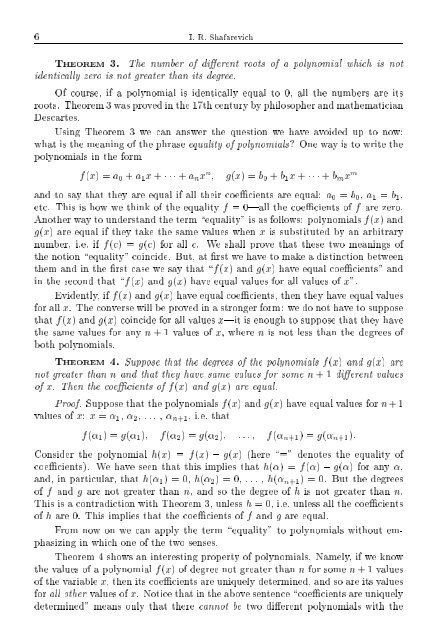SELECTED CHAPTERS FROM ALGEBRA I. R. Shafarevich Preface
SELECTED CHAPTERS FROM ALGEBRA I. R. Shafarevich Preface
SELECTED CHAPTERS FROM ALGEBRA I. R. Shafarevich Preface
Create successful ePaper yourself
Turn your PDF publications into a flip-book with our unique Google optimized e-Paper software.
6 I. R. <strong>Shafarevich</strong>THEOREM 3. The number of dierent roots of a polynomial which is notidentically zero is not greater than its degree.Of course, if a polynomial is identically equal to 0, all the numbers are itsroots. Theorem 3 was proved in the 17th century by philosopher and mathematicianDescartes.Using Theorem 3 we can answer the question we have avoided up to now:what is the meaning of the phrase equality of polynomials? One way is to write thepolynomials in the formf(x) =a 0 + a 1 x + + a n x n g(x) =b 0 + b 1 x + + b m x mand to say that they are equal if all their coecients are equal: a 0 = b 0 , a 1 = b 1 ,etc. This is how we think of the equality f = 0|all the coecients of f are zero.Another way to understand the term \equality" is as follows: polynomials f(x) andg(x) are equal if they take the same values when x is substituted by an arbitrarynumber, i.e. if f(c) = g(c) for all c. We shall prove that these two meanings ofthe notion \equality" coincide. But, at rst we have tomake a distinction betweenthem and in the rst case we saythat\f(x) andg(x) have equal coecients" andin the second that \f(x) andg(x) have equal values for all values of x".Evidently, iff(x) and g(x) have equal coecients, then they have equal valuesfor all x. The converse will be proved in a stronger form: we do not havetosupposethat f(x) andg(x) coincide for all values x|it is enough to suppose that they havethe same values for any n +1values of x, where n is not less than the degrees ofboth polynomials.THEOREM 4. Suppose that the degrees of the polynomials f(x) and g(x) arenot greater than n and that they have same values for some n +1 dierent valuesof x. Then the coecients of f(x) and g(x) are equal.Proof. Suppose that the polynomials f(x) and g(x) have equal values for n +1values of x: x = 1 , 2 ,..., n+1 , i.e. thatf( 1 )=g( 1 ) f( 2 )=g( 2 ) ... f( n+1 )=g( n+1 ):Consider the polynomial h(x) = f(x) ; g(x) (here \=" denotes the equality ofcoecients). We have seen that this implies that h() = f() ; g() for any ,and, in particular, that h( 1 )=0,h( 2 )=0,...,h( n+1 )=0. But the degreesof f and g are not greater than n, and so the degree of h is not greater than n.This is a contradiction with Theorem 3, unless h = 0, i.e. unless all the coecientsof h are 0. This implies that the coecients of f and g are equal.From now on we can apply the term \equality" to polynomials without emphasizingin which one of the two senses.Theorem 4 shows an interesting property of polynomials. Namely, ifweknowthe values of a polynomial f(x) of degree not greater than n for some n +1valuesof the variable x, then its coecients are uniquely determined, and so are its valuesfor all other values of x. Notice that in the abovesentence \coecients are uniquelydetermined" means only that there cannot be two dierent polynomials with the
















